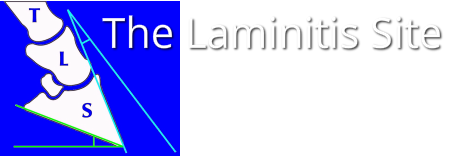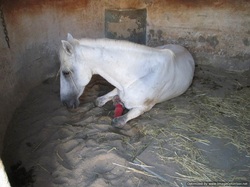| Casareño, a 16 year old Andalusian, developed laminitis in all four feet in May, five days after having a corticosteroid injection (6 mg Celestone - betamethasone) for a suspected pastern joint sprain. 03 June - x-rays showed a large palmar angle (not measured by the vet) of around 15 degrees. The treating vet applied casts that raised the heels, further increasing the palmar angle and presumably the pressure on the tip of P3. |
TLS recommended the rehabilitation protocol published by Debra Taylor et al. (2014) - remove shoes, fully realign the feet, support with thick pads - and on 10 July the shoes and wedges were removed, but the feet were only trimmed to tidy up frogs and bars. The vet declared that carrying out a realigning trim could be "a disaster" and that the long toes and high heels should not be corrected until more sole depth had developed (TLS disagreed!). The frogs were infected with thrush, which is common when heels are too high.
17 July - x-rays showed slightly increased palmar and dorsal rotation, which would be expected with no recent trimming. Personal correspondence from Debra Taylor backed the argument for commencing the realigning trim. The vet admitted that the situation was very bad and that something must be done as soon as possible, and agreed that a barefoot trimmer could be instructed. The owner feared that Casareño could be heading towards euthanasia.
13 Aug - after two trims (apparently without reference to the TLS suggested trim), very little progress had been made with realignment, and an abscess was now evident in the sole beneath, and very close to, the tip of P3. A third hoofcare professional was instructed, and guided by mark ups from TLS, realigning trimming finally got underway.
25 Aug - after just one trim the dorsal and palmar angles were reduced. Casareño was finally off of NSAIDs and moving better.
15 Sept - after two further realigning trims the toe was looking much better, but the palmar angle was still too high. Note the gas pocket indicating abscessing beneath the tip of P3, and the change in the hoof wall at the toe. At this point Casareño had increased but not full comfort, due probably to a combination of the feet still not being fully realigned, the solar abscess on the right fore, and heel rubs from wearing boots in a sandy environment.
9 Oct - two trims guided by the previous x-rays brought the heels down, reducing the palmar angle further, but probably still not quite far enough. Note how the frog apex, marked by a drawing pin (that should have had the pin shortened much further!), had migrated forwards - the true frog apex will always be behind the tip of P3. Casareño was now being walked out in-hand.
01 Dec - the feet had remained stable but probably still needed a little more off the heels to bring the palmar angle down to between 3 and 5 degrees. This should be guided by the live sole - which can be difficult to find on dry compacted feet that have had high heels for a long time. Note that the black gas pocket indicating the abscess has grown out and healthy tissue appears to be supporting P3. The true frog apex has been identified and the frog trimmed back, so the true apex can again be used to guide the trim. Note the clear shape of the collateral grooves on the x-ray. Note also the first radiographic signs of bone remodelling at the tip of P3 - we suspect this is due to the long-term high palmar angle and pressure on the tip of P3. Casareño is now in regular in-hand work and being turned out, with his feet protected by boots and pads.
In November Casareño's vet posted on owner Pat's Facebook page: "I'm super happy to see Casereño recovered. Now you're probably the person who knows most of laminitis in Spain and I must admit that you made me crazy with so many articles you've read ....hahaha!!
Was fortunate to have the help of people The Laminitis Site but especially with the professionalism of an expert as is the blacksmith Bryn Simmo ..... GRACIAS Pat!!!"
Raising the heel has unfortunately been advocated for laminitis cases for some time. TLS can see no justification whatsoever for doing this - see Don't raise the heel! Instead, in Care and Rehabilitation of the Equine Foot, p 351, Pete Ramey says "at the first signs of laminitis, restore P3 to a more natural ground plane, relieve pressure on the walls and pad the sole with foam rubber – vertical sinking and destructive pressure to the solar corium can be prevented”. Pete also says, on p 350, "I believe that DDFT tension concerns have held back the veterinary and farrier world, preventing rotation reversal by leading people to stand P3 up on its tip and ultimately destroying the foot."
The video below shows Casareño's progress from being crippled in July to jumping for joy in December:
References:
Taylor D, Sperandeo A, Schumacher J, Passler T, Wooldridge A, Bell R, Cooner A, Guidry L, Matz-Creel H, Ramey I, Ramey P
Clinical Outcome of 14 Obese, Laminitic Horses Managed with the Same Rehabilitation Protocol
Journal of Equine Veterinary Science Volume 34, Issue 4, Pages 556–564, April 2014


 RSS Feed
RSS Feed